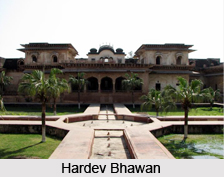 The Hardev Bhawan in Deeg Palace, Rajasthan lies immediately at the back of Suraj Bhawan and forms a charming quadrangle around an attached inner garden. This kind of set up was very common with the royal houses of the Middle Ages especially during the time of the Mughals.
The Hardev Bhawan in Deeg Palace, Rajasthan lies immediately at the back of Suraj Bhawan and forms a charming quadrangle around an attached inner garden. This kind of set up was very common with the royal houses of the Middle Ages especially during the time of the Mughals.
The corner position of Hardev Bhawan questions its chance of being an original part of the main Bhawan complex. It is most likely that this mansion was later rebuilt by Suraj Mai, the ruler of Bharatpur according to his taste and need. Its northern wing was destroyed to have room for the Suraj Bhawan. However, the flipside portion of the building is original. The main block of Hardev Bhawan on the south is two storeyed and has an impressive position over looking the ornamental garden. The lower floor consists of a projecting central hall, faced with arches springing from a row of double pillars. Behind the front arches is an arched row of pillars running along the three sides of the internal group of four pillars roughly similar to those existing within the side wings of the Gopal Bhawan. The feature of an oblong corridor with raised floor and domed cell is analogous to those of Suraj Bhawan. A rectangular compartment with a verandah bordered by cells has been constructed on either hand of the hall. On the east a comfortable slope offer admission to the upper storey, that has a railed central terrace and two pillared dalans on either side. The rear part of the terrace of Hardev Bhawan is occupied by a crowning chhatri bearing a spiked curved-roof graced with miniature side-domes. A thin gallery, displayed with obliquely-cut jalis runs at the back of the upper floor.
The position of the Hardev Bhawan implies that it was meant for noble families. The garden of Hardev Bhawan is strictly of a private nature suitable for ladies" quarters. The jets studded in the four garden canals are very small and are modeled after the lotus-bud without any sculptured body. But whether this is original or a later alteration is difficult to guess.
This article is a stub. You can enrich by adding more information to it. Send your Write Up to content@indianetzone.com



















